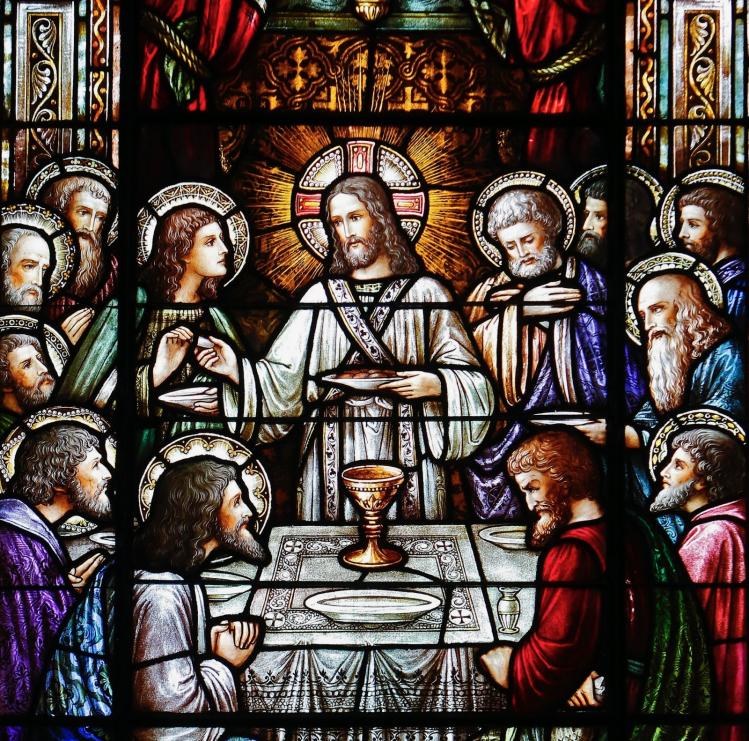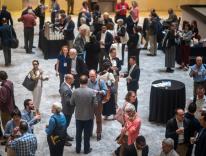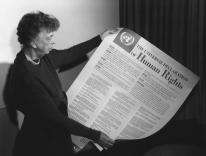
As many readers will know, the United States Conference of Catholic Bishops is leading a three-year National Eucharistic Revival. It began with locally organized parish and diocesan events on the Feast of Corpus Christi, 2022. The coming year, 2024, will feature nationally organized events, culminating in the 10th National Eucharistic Congress—the first in eighty-nine years—to be held in Indianapolis July 17–24. The idea of the Revival was partly motivated by recent studies that seemed to reveal that a shockingly small percentage of Catholics actually believe in the Real Presence of Christ in the Eucharist. The Revival has, therefore, promoted the renewal of catechetical efforts in teaching eucharistic doctrine, emphasizing especially the unique, substantial presence of Christ.
In this regard, it is important to remember—though it may seem unrelated—that “the Eucharist commits us to the poor.” So says the Catechism of the Catholic Church (1397).
This corresponds to an ancient Christian intuition rooted in Scripture (see, for example, James 2:2–4). We find it already well developed in Justin Martyr, who, in his First Apology, famously describes the eucharistic celebration at Rome in the middle of the second century. He emphasizes that the “eucharistized bread and wine” are not received “as common bread nor common drink,” but are, “by transformation,” the “flesh and blood of Jesus,” the Word of God who became incarnate by taking on both flesh and blood “for our salvation.” Justin is very conscious that the “flesh and blood” of the Eucharist is not just an inert reality whose principal attraction is that it was miraculously produced. It is someone’s flesh and blood, that of the very “Logos” or “Word” or “Reason” of God, who took it on “for our salvation.” It is the body of someone who willed to suffer and die, and in that body he rose. Risen, he is present in his “flesh and blood.” In the story of this flesh and blood, we see God’s Reason displayed, the very “Rationale” of created reality. “Eucharist” means “thanksgiving,” and the celebration of the Eucharist is the Thanksgiving par excellence. Just as the Word of God became visible to us by taking on flesh and blood for our salvation, so, in being “eucharistized” (we could say, “thanksgiving-ized”), the transformed bread and wine make the very flesh and blood that the Word took on “for our salvation” visibly present again, making him, the foundation of reality revealed as mercy, present again.
At the same time, the poor and the vulnerable also rise to visibility. Justin adds that immediately following the Eucharist, “the wealthy come to the aid of the poor.” He mentions that the deacons take up a collection for the use of the presider, charged with the care of orphans and widows, the sick, the imprisoned, resident aliens, indeed “all those in need.” This, for Justin, is a matter of sheer gratitude. Formed in the gratitude for the gift we are celebrating, the needs of the poor are recovered from invisibility and distance. Eucharistic realism means we see the poor and vulnerable, just as we see the Real Presence. We learn to see as God’s merciful Reason sees. Whether Justin knew the Letter of James or not, he echoes its rebuke of those who would put the poorer members of the assembly in the least visible, lowest-status positions. In a homily, John Chrysostom also speaks of how the Eucharist ought to adjust our vision: “You have tasted the blood of the Lord, yet you do not recognize your brother.… God freed you from all your sins and invited you here, but you have not become more merciful.” Eucharistic realism is here short-circuited.
Justin’s theology was developed partly in reaction against the charge that Christians participated in “Thyestean banquets.” This phrase recalls the story of Atreus, who served his brother Thyestes a banquet consisting of the flesh of Thyestes’s own children in retaliation for Thyestes’s seduction of Atreus’s wife. Note, this is not just a generic charge of cannibalism. Atreus regarded his brother’s vulnerable and powerless children as totally dispensable. Justin distinguishes eucharistic realism from the grim realism of a world where power and status define reality and the poor and vulnerable are instrumentalized and rendered invisible—“eaten.” Justin is defending a different kind of realism, made present in a new kind of banquet where the vulnerable are not eaten but rise to visibility.
The Church’s continuing reflection on eucharistic presence is rooted in the sensibility to which Justin is an early witness. To be in continuity with Justin, eucharistic realism must make us see that mercy, not power, is the foundational reality worthy of worship. Justin avoids an overly physicalist understanding of the Eucharist, one that would make the flesh and blood of Christ an inert object like the flesh of the children served up in the myth of Atreus. The Eucharist is not to be understood as a thing at our disposal and under our power, together with the miracle which produces it.
Paul VI was careful to distinguish Christ’s presence as unique and to mark that uniqueness by the use of the word “substantial”: it is “presence in the fullest sense,” he says, “that is to say, it is a substantial presence by which Christ, God and man, makes himself wholly and entirely present” (Mysterium Fidei, 39, cited at CCC 1374). Here he echoes Trent: “In the most blessed sacrament of the Eucharist ‘the body and blood, together with the soul and divinity, of our Lord Jesus Christ and, therefore, the whole Christ, is truly, really, and substantially contained’” (CCC, 1374, citing the Council of Trent). This is why the transformation is called “transubstantiation,” because “by the consecration of the bread and wine there takes place a change of the whole substance of the bread into the substance of the body of Christ our Lord and of the whole substance of the wine into the substance of his blood” (CCC, 1376, again citing Trent).
It is true that later in the same text, Paul VI notes that “once the substance or nature of the bread and wine has been changed into the body and blood of Christ, nothing remains of the bread and the wine except for the species—beneath which Christ is present whole and entire in His physical ‘reality,’ corporeally present, although not in the manner in which bodies are in a place.” But Paul VI is careful not to say that Christ is present “physically.” Of course, if it is body and blood, it is corporeal; and bodies are a physical reality, but Christ’s body is present not “in the manner in which bodies are in a place.” These words echo the explanations of Thomas Aquinas, who specifies that presence “according to substance” is distinguished from ordinary presence in space. If Christ’s presence were mere ordinary physical presence, then when the Host was broken and divided, the body of Christ would be broken and divided—and ultimately chewed up as the children in a Thyestean feast would be.
Just as Justin taught, this is a different kind of feast. Because Christ is substantially and not physically present, each communicant receives him—not just an inert “piece” of him, but all of him. His complete self-giving act of mercy is offered to us under these visible forms, with nothing held back, neither body, blood, soul nor divinity. Just as in Justin, the mechanism of this presence is not explained, but the doctrine of transubstantiation gives us a vocabulary for articulating this presence in a way that definitively distinguishes it from a Thyestean feast.
The doctrine of transubstantiation thereby helps connect eucharistic realism to the Church’s commitment to the poor and vulnerable. This connection has been forcefully rearticulated by both Popes Benedict and Francis. After explaining that the doctrine of transubstantiation means that in the Eucharist we do not receive “a thing,” but Christ himself, made present in the hour of his oblation, Benedict says:
It is precisely this personal encounter with the Lord that then strengthens the social mission contained in the Eucharist, which seeks to break down not only the walls that separate the Lord and ourselves, but also and especially the walls that separate us from one another. (Sacramentum caritatis, 66)
Being drawn by the sacrament into Jesus’ self-gift creates what Benedict later called a “sacramental mysticism,” which, he says, is “social in character.” Benedict continues, “Union with Christ is also union with all those to whom he gives himself. I cannot possess Christ just for myself…. A Eucharist which does not pass over into the concrete practice of love is intrinsically fragmented” (Deus caritas est, 14).
I like the expression “sacramental mysticism,” but I’d also like to suggest the phrase sacramental, or eucharistic, realism. One does not usually find an exploration of the idea of transubstantiation in a paragraph together with the exploration of the preferential option for the poor. But if the poor are all those who are “unreal” to us, invisible and unseen—not only those in literal poverty but anyone whose presence we are blind to because of our social and personal preferences—then perhaps it is not so unlikely to put these ideas together. Devotion to Christ in his eucharistic presence is devotion to his concrete, real poverty, the poverty of our flesh. And the more one is formed in such a realism, the more it enables one to see the reality of his flesh in the poor whom he espouses in the sacrifice of the Mass.
Pope Francis, for his part, speaks about the Eucharist in extravagant terms that presuppose the doctrine of Christ’s substantial presence in the Eucharist: “The Eucharist is the living center of the universe, the overflowing core of love and of inexhaustible life. Joined to the incarnate Son, present in the Eucharist, the whole cosmos gives thanks to God.” The Eucharist thereby “sheds light on the whole week, and motivates us to greater concern for nature and the poor” (Laudato si’, 236–37). Creation itself, joined to the cosmic act of love that is the Eucharist, rises to visibility in and with the eucharistic elements. The Eucharist enables the earth itself, “among the most abandoned and maltreated of our poor,” to be recovered from the Thyestean feasts in which it is served up as mere matter to be consumed.
In this year of eucharistic revival, it is worth asking if one of the reasons that so many Catholics now say that they do not believe in the eucharistic Real Presence is that this ancient and intrinsic dimension of eucharistic realism has been overlooked. The full impact of the Real Presence is thereby diminished; it becomes fetishized as a sacred object that Catholics have and others don’t. But this almost sectarian approach is contrary to the dynamism of transubstantiation itself, which turns the Church outward to the world that God “so loved that he gave His only-begotten Son” (John 3:16), who, out of mercy, “emptied himself and took on the form of a servant” (Philippians 2:7).
In Loaves and Fishes, Dorothy Day recalls the priestly service of Fr. Pacifique Roy to the Catholic Worker community: “During even the coldest weather, when the water froze in the cruet and his hands became numb, he said Mass slowly, reverently, with a mind intent on the greatness, the awfulness of the Sacrifice.” The awfulness of the Sacrifice is reflected not only in Fr. Roy’s gestures but in the frozen water of the cruet, the hard reality of the poor, made visible because of that community’s commitment to serve them. “The Eucharist commits us to the poor.” Perhaps our own eucharistic realism would be enhanced if we, too, committed ourselves to embracing the “awfulness of the Sacrifice” in its full dimensions.
Please email comments to [email protected] and join the conversation on our Facebook page.
Previous Story
Is AI Poised to Replace Humanity?
Next Story
Joseph Strickland Is Still a Bishop


